OCZ Vertex 3 MAX IOPS & Patriot Wildfire SSDs Reviewed
by Anand Lal Shimpi on June 23, 2011 4:35 AM ESTAnandTech Storage Bench 2011
Last year we introduced our AnandTech Storage Bench, a suite of benchmarks that took traces of real OS/application usage and played them back in a repeatable manner. I assembled the traces myself out of frustration with the majority of what we have today in terms of SSD benchmarks.
Although the AnandTech Storage Bench tests did a good job of characterizing SSD performance, they weren't stressful enough. All of the tests performed less than 10GB of reads/writes and typically involved only 4GB of writes specifically. That's not even enough exceed the spare area on most SSDs. Most canned SSD benchmarks don't even come close to writing a single gigabyte of data, but that doesn't mean that simply writing 4GB is acceptable.
Originally I kept the benchmarks short enough that they wouldn't be a burden to run (~30 minutes) but long enough that they were representative of what a power user might do with their system.
Not too long ago I tweeted that I had created what I referred to as the Mother of All SSD Benchmarks (MOASB). Rather than only writing 4GB of data to the drive, this benchmark writes 106.32GB. It's the load you'd put on a drive after nearly two weeks of constant usage. And it takes a *long* time to run.
1) The MOASB, officially called AnandTech Storage Bench 2011 - Heavy Workload, mainly focuses on the times when your I/O activity is the highest. There is a lot of downloading and application installing that happens during the course of this test. My thinking was that it's during application installs, file copies, downloading and multitasking with all of this that you can really notice performance differences between drives.
2) I tried to cover as many bases as possible with the software I incorporated into this test. There's a lot of photo editing in Photoshop, HTML editing in Dreamweaver, web browsing, game playing/level loading (Starcraft II & WoW are both a part of the test) as well as general use stuff (application installing, virus scanning). I included a large amount of email downloading, document creation and editing as well. To top it all off I even use Visual Studio 2008 to build Chromium during the test.
The test has 2,168,893 read operations and 1,783,447 write operations. The IO breakdown is as follows:
| AnandTech Storage Bench 2011 - Heavy Workload IO Breakdown | ||||
| IO Size | % of Total | |||
| 4KB | 28% | |||
| 16KB | 10% | |||
| 32KB | 10% | |||
| 64KB | 4% | |||
Only 42% of all operations are sequential, the rest range from pseudo to fully random (with most falling in the pseudo-random category). Average queue depth is 4.625 IOs, with 59% of operations taking place in an IO queue of 1.
Many of you have asked for a better way to really characterize performance. Simply looking at IOPS doesn't really say much. As a result I'm going to be presenting Storage Bench 2011 data in a slightly different way. We'll have performance represented as Average MB/s, with higher numbers being better. At the same time I'll be reporting how long the SSD was busy while running this test. These disk busy graphs will show you exactly how much time was shaved off by using a faster drive vs. a slower one during the course of this test. Finally, I will also break out performance into reads, writes and combined. The reason I do this is to help balance out the fact that this test is unusually write intensive, which can often hide the benefits of a drive with good read performance.
There's also a new light workload for 2011. This is a far more reasonable, typical every day use case benchmark. Lots of web browsing, photo editing (but with a greater focus on photo consumption), video playback as well as some application installs and gaming. This test isn't nearly as write intensive as the MOASB but it's still multiple times more write intensive than what we were running last year.
As always I don't believe that these two benchmarks alone are enough to characterize the performance of a drive, but hopefully along with the rest of our tests they will help provide a better idea.
The testbed for Storage Bench 2011 has changed as well. We're now using a Sandy Bridge platform with full 6Gbps support for these tests. All of the older tests are still run on our X58 platform.
AnandTech Storage Bench 2011 - Heavy Workload
We'll start out by looking at average data rate throughout our new heavy workload test:
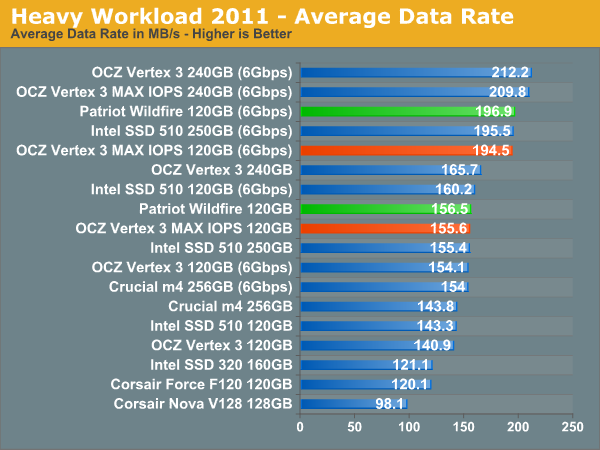
The breakdown of reads vs. writes tells us more of what's going on:
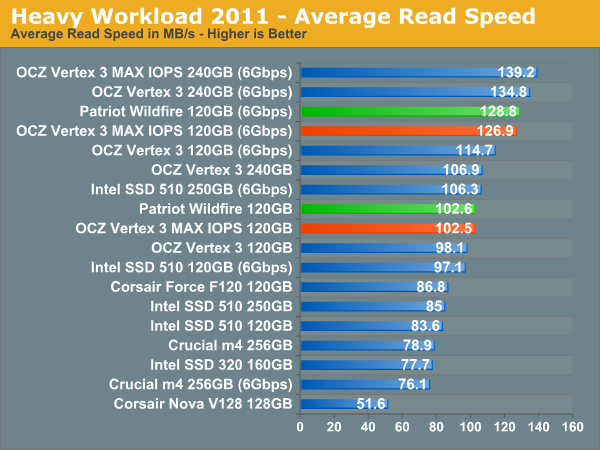
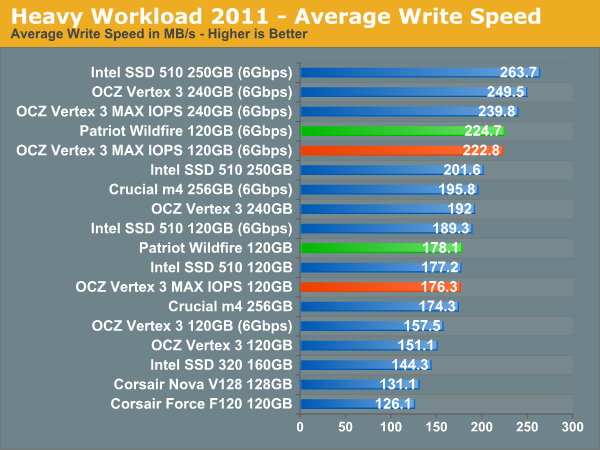
The next three charts just represent the same data, but in a different manner. Instead of looking at average data rate, we're looking at how long the disk was busy for during this entire test. Note that disk busy time excludes any and all idles, this is just how long the SSD was busy doing something:
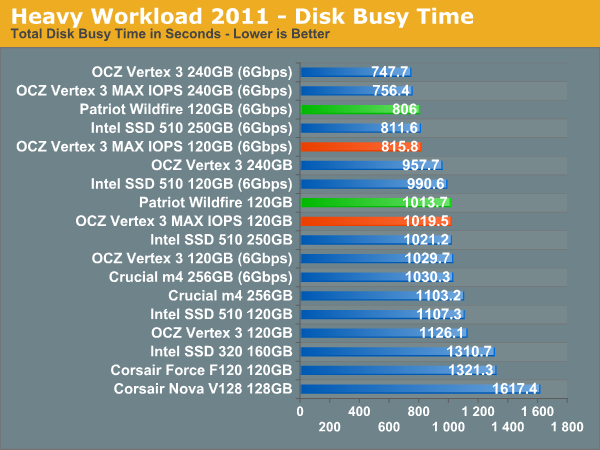
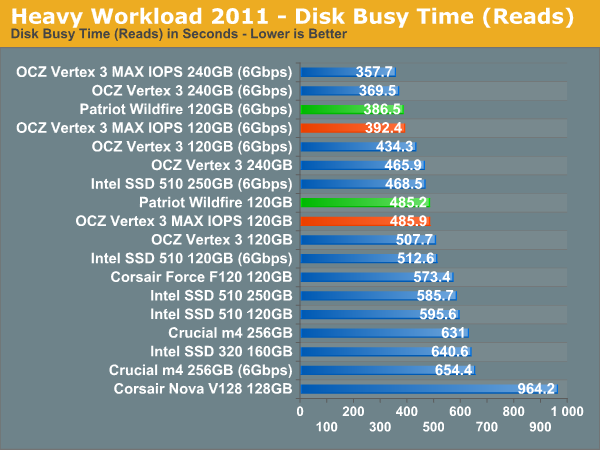
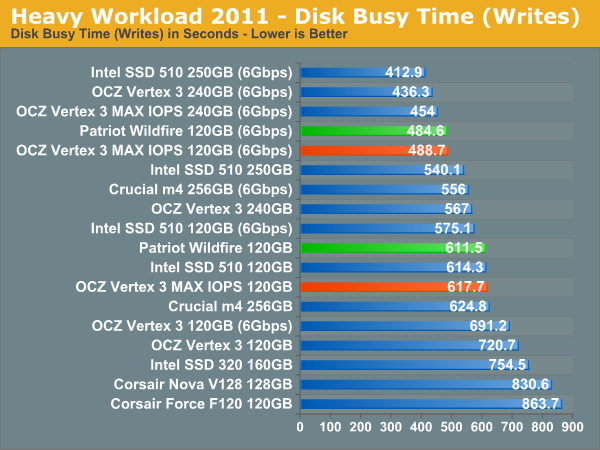










112 Comments
View All Comments
PartEleven - Sunday, June 26, 2011 - link
Anand, I'm hoping this question reaches you but I was wondering if you can comment on the Vertex 3 oem version, the V3LT-25SAT3-240G.oem. Official specs rate it as slightly slower than the retail Vertex 3, but when people asked about it on the ocz forums the mods there say it's because of different NAND. Supposedly this drive uses the same Toshiba 32nm toggle nand used as these MAX IOPS drives. Why is it then that the oem drives are slower than the MAX IOPS drives? I thought at first they might be using higher density chips so you have less NAND dies running in parallel, but you mention here that Toshiba's NAND only gets 4GB per die. What do you think is the cause for the performance difference? OCZ seems pretty reluctant to give a detailed answer.cakeab - Sunday, June 26, 2011 - link
--Something unexpected surprise--
Hello. My friend
=== {{w w w }} {{be tter whole saler }} {{ u s }} ====
Dedi cated service, the new style, believing you will love it!!!
WE ACCEPT PYA PAL PAY MENT
YOU MUST NOT MISS IT!!!
thank you!!!
-- w w w . jordan forworld . c o m -
aritai - Sunday, June 26, 2011 - link
Has been working well (no bluescreens, no crashes, no hangs, no issues w/ sleep-resume or use of bitlocker on the drive) with a Thinkpad W520/4270CT since first week of April (W7ultimate+SP1, current w/ MS, NVIDIA and Lenovo patches and drivers).However on a restart (but not on a shutdown to power off followed by power back on) there's some SATA3/Intel/IBM BIOS issue that seems to hang on the SSD read - it eventually times out (after perhaps as long as a minute) and continues booting. Rather than wait, an option is to simply force a power off (hold power button for 5 seconds) followed by re-powering on. A minor nit given Lenovo has yet to announce support for 6gbyte/s SSDs, and other than this the 4core/8thread 16gbyte dram sandybridge machine is a developer's dream (I run a handful of VMs on a 2nd SSD in the media bay, can't even tell they're VMs).
And with the 2nd-battery (that attaches on the bottom like a mini-dock), I can work all the way to Hong Kong (14+ hours) on batteries (a good thing, since there's no travel adapter yet - and may never be given they want to support 2 hour recharge and require 170W supply that no seat power can deliver. Which is a pity because the W520 automagically switches to integrated graphics and Intel turns off cores (so power meter shows < 8 watt average use in extended battery life mode). So even a 60 watt travel adapter world work save for Lenovo's BIOS doesn't / has yet to permit it.
danrichards - Tuesday, June 28, 2011 - link
MTBF, Mean Time Between Failure. Frequently advertised at 2+million hours. What kind of claim is this?Does this mean I place the drive on the shelf for 200 years, put it in to an antique computer in 200 years and it should still work? Until otherwise proven, I think so...
I bought 60GB Agility 2 for my laptop and a 120GB Vertex 3 for my desktop and both failed within two months. I'm in the process of returning one to Newegg and replacing another with OCZ (the Agility 2 for the 2nd time). The Vertex 3, I got a F4 BSOD at least twice daily (I didn't think it was possible to have 2 bad drives so I spent too many hours parting out my system and formatting it 3 times and trying different drivers to no success). Newegg was sympathetic and gave me a refund after the 30 refund period.
By the way, when one of these drive fails, there is no getting out Stellar Phoenix and recovering your data, they just pop and your data is vaporized. Do not use a SSD unless you have a solid backup plan...and don't even think using an SSD will increase your productivity. If I added up the downtime from work, frustration time, and troubleshooting time I spend with my machines, I'll give that up for a fast HDD that lasts 3-5 years (and is recoverable) and takes 4-5 seconds longer to load my Outlook.
I was extremely enthusiastic about SSDs and I'm disappointed to detail such a poor report.
PR3ACH3R - Wednesday, June 29, 2011 - link
I must agree with everything you said, its sad it is up to small builders & forum members to set the record straight about the SSD situation.If theres anything you got wrong is the MTBF abbrev ..
regarding SSDs it actually means: Mad Total Bork Freakshow.
jcompagner - Tuesday, June 28, 2011 - link
I was one of the first here that had a 240GB V3. That had the initial firmware of 2.02, with that firmware installing on my Dell XPS17 (SandyBridge) notebook that was quite difficult to do.But after i find out about 2 things: 1 use the latest intel rapid store driver (else BSOD directly after install with the first boot) and after install make sure you disable the LPM settings (else you will get stutter) everything was pretty smooth i had no BSOD after that and it was quite solid.
So the only problem with V3 was the install part on a laptop of Dell which is quite a high volume laptop out there. (and yes there are plenty other dell laptops that have the same problem because underneath they use pretty much the same stuff)
What i don't get is why OCZ seems to test many things on desktop boards, i hear always Asus board X or Gigabyte board Y. But who is using that? SSD are the perfect things in laptops because there is where the most gain is, and i wonder who is using desktops anyway currently (i don't know them anymore)
After that firmware 2.06 came out and then i made a mistake by upgrading to it (and let me say that the upgrade for a system drive what in a laptop almost always is the case....) is quite hard. But after that BSOD started happening.. 2.08 same stuff still BSOD, now with 2.09 BSOD stopped it is solid again, and i must say that my performance is still quite good. i don't notice in real life or with testing any real performance penalty.
So now for me everything is quite good again. I never reinstalled or did a secure erase (that really cost a lot of time!) .
But i wouldn't really recommend to none real technical users a OCZ drive at the moment. Installation, firmware updates are all quite hard and you really know what to do.
kaikaihhh - Tuesday, June 28, 2011 - link
hello,welcome to www.voguecatch.us,there have more top goods,like hand bag,t shirt,sun glass and so
on ,i hope everyone will like them,thanks
doodles - Sunday, July 10, 2011 - link
You asked what I'd do if I won a Eee Pad Transformer or a Samsung Galaxy Tab 10.1...so many ideas came to mind that I felt my skull crack. I'd keep up with my husband's medicines, (lung cancer), set reminders, keep his appointment schedules, And it might even entertain me while I do that interminable waiting in the dr.'s office.AeroJoe - Wednesday, July 13, 2011 - link
Exactly which version of Iometer are you using these days to run your benchmarks? The latest version at www.iometer.org is many years old - or am I looking in the wrong spot?Jphelps2630 - Monday, July 18, 2011 - link
I'm one of the lucky owners of a Vertex 3 that has the BSOD problems. Just can't get it stable. Besides BSODs, it disappears from the BIOS and corrupts the file system so Windows and Office are trashed a couple of hours after loading. It's been upgraded to the latest 2.09 firmware which didn't help.Very disappointing product. Spent a lot of money and it just doesn't work. Waiting for help from OCZ. Will let you know what they say.
I7 2600k on Asus p8z68 pro, 8gb Corsair RAM, Win7 64